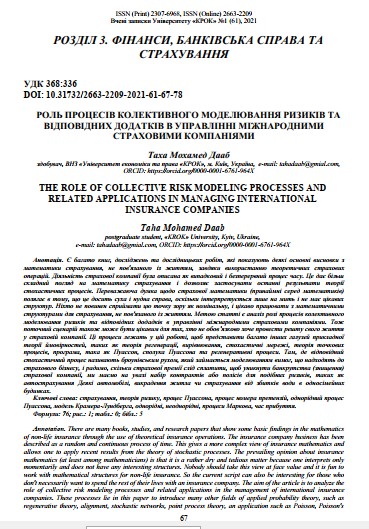THE ROLE OF COLLECTIVE RISK MODELING PROCESSES AND RELATED APPLICATIONS IN MANAGING INTERNATIONAL INSURANCE COMPANIES
DOI:
https://doi.org/10.31732/2663-2209-2021-61-67-78Keywords:
insurance, risk theory, the Poisson process, claim number process, the homogeneous Poisson process, the Kramer-Lundberg model, homogeneous, Inhomogeneous, Markov processes, arrival timesAbstract
There are many books, studies, and research papers that show some basic findings in the mathematics of non-life insurance through the use of theoretical insurance operations. The insurance company business has been described as a random and continuous process of time. This gives a more complex view of insurance mathematics and allows one to apply recent results from the theory of stochastic processes. The prevailing opinion about insurance mathematics (at least among mathematicians) is that it is a rather dry and tedious matter because one interprets only momentarily and does not have any interesting structures. Nobody should take this view at face value and it is fun to work with mathematical structures for non-life insurance. So the current script can also be interesting for those who don't necessarily want to spend the rest of their lives with an insurance company. The aim of the article is to analyze the role of collective risk modeling processes and related applications in the management of international insurance companies. These processes lie in this paper to introduce many other fields of applied probability theory, such as regenerative theory, alignment, stochastic networks, point process theory, an application such as Poisson, Poisson's compound, and regenerative processes. Where the appropriate stochastic process has been called the Brownian movement, which deals with the modeling of claims that reach the insurance business, which advice on how much insurance premium should be paid to avoid bankruptcy (destruction) of the insurance company by this we mean a set of contracts or policies for similar risks such as auto insurance Certain cars, home theft or water damage insurance in single-family homes.
Downloads
References
Thomas, M. (2006), Non-Life Insurance Mathematics: An Introduction with Stochastic Processes Springer.Second Printing.
Yuliya, M. (2015), Optimization in Insurance and Finance Set coordinated: Financial Mathematics. ISTE Press Ltd and Elsevier Ltd.
Venkatarama, K. (1984), Nonlinear Filtering and Smoothing: An Introduction to Martingales, Stochastic Integrals, and Estimation. DOVER PUBLICATIONS, INC.
Yuliya, M., & Georgiy, S., (2017), Theory and Statistical Applications of Stochastic Processes. Wiley-ISTE.
Ivan, N. (2012), Selected Aspects of Fractional Brownian Motion. B&SS – Bocconi & Springer Series.



